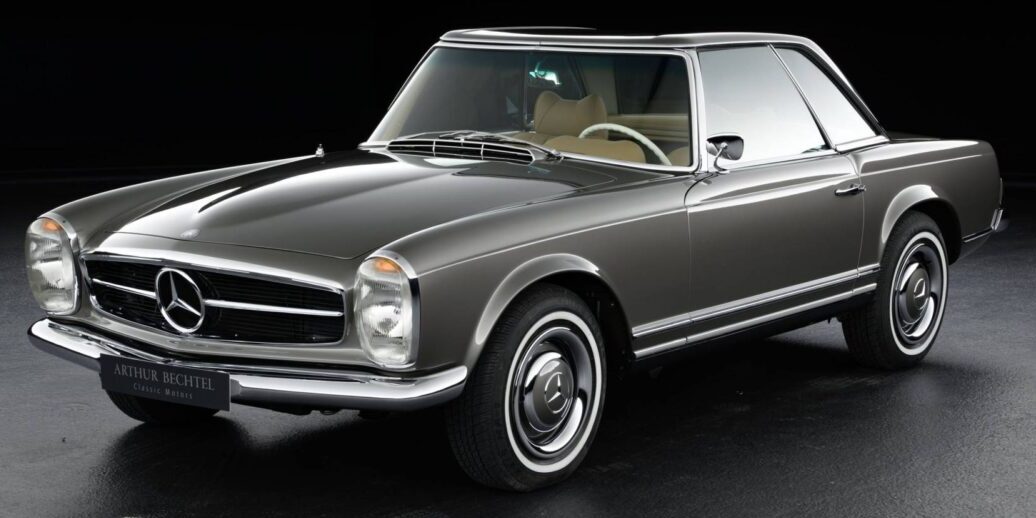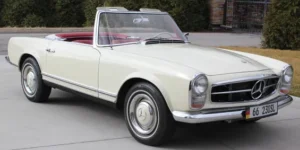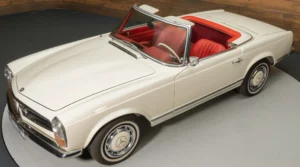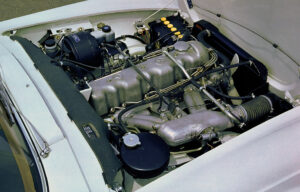Mercedes 230SL: A timeless icon of performance and elegance
1. The legacy of the Mercedes-Benz 230SL: A blend of performance and elegance
2. A successor to the 190SL and 300SL
3. The engineering marvel: 230SL performance and design
5. Advanced powertrain and handling
6. Safety and comfort features
7. Evolution and final production
8. Conclusion
The legacy of the Mercedes-Benz 230SL: A blend of performance and elegance
The Mercedes-Benz 230SL (W113) is a legendary model that marked a turning point in the evolution of the SL series. Introduced in March 1963 at the Geneva Motor Show, this innovative vehicle bridged the gap between the exotic 300SL and the more practical 190SL, offering a perfect balance of performance, style, and everyday usability. With its introduction, Daimler-Benz set new standards in automotive engineering, combining cutting-edge technology with a sleek, modern design.
A successor to the 190SL and 300SL
The production of the 300SL and 190SL came to an end in February 1963, making way for the next generation of Sport Licht models. While the 300SL was a masterpiece of engineering, it was produced in limited numbers. The 190SL, on the other hand, enjoyed widespread popularity, leading Mercedes-Benz to design a worthy successor that would appeal to a broader market. The 230SL was created to combine the practicality of the 190SL with the performance enhancements of the 300SL, making it an ideal grand touring vehicle.
The engineering marvel: 230SL performance and design
As noted by Road & Track during the debut of the W113 series, the 230SL was positioned between the 300SL and 190SL in almost every aspect. The 2.3-liter, fuel-injected inline-six engine delivered 170 horsepower, placing its performance squarely between the 120-horsepower 190SL and the 250-horsepower 300SL. This powertrain allowed the 230SL to offer a refined driving experience, combining the smoothness of a sedan with the agility of a sports car.
One of the most distinctive features of the 230SL was its iconic removable hardtop, famously known as the “Pagoda” roof. This unique design provided three configurations: an open-top roadster, a soft-top convertible, and a coupe with the hardtop in place. The concave design of the roof not only added aesthetic appeal but also improved structural rigidity and visibility.
Development and innovation
The development of the W113 SL series began in October 1958 under the leadership of Fritz Nallinger. Hans Scherenberg later took over as Technical Director, while the renowned designer Paul Bracq, under the supervision of Friedrich Geiger, refined the car’s aesthetics. The final design incorporated engineering elements prescribed by Rudy Uhlenhaut, Karl Wilfert, and Bela Barényi, ensuring that safety and functionality were at the forefront of the vehicle’s development.
Unlike the 190SL, which borrowed heavily from the 180 sedan, the 230SL was built on a shortened floorpan from the 220SEb “Fintail” sedan, introduced in 1959. This resulted in a modern, sleek design that was unmistakably Mercedes-Benz. The W113 series’ straight-line styling and sharp character lines were a departure from the rounded curves of its predecessors, making the 230SL a standout model of its era.
Advanced powertrain and handling
The 230SL’s 2.3-liter inline-six engine (M127.981) was an evolution of the final six-cylinder “Ponton” unit rather than a direct derivative of the W111 series engines. By increasing the bore from 80mm to 82mm while retaining the 72.8mm stroke, the engine achieved a displacement of 2,306cc. With an upgraded Bosch fuel injection system, larger valves, a higher compression ratio (9.3:1), and a modified exhaust manifold, the 230SL produced 150 DIN horsepower—a significant improvement over previous models.
Transmission options included a standard four-speed manual gearbox and, for the first time in an SL model, an optional Daimler-Benz four-speed automatic transmission. The automatic featured a staggered selector gate to minimize accidental shifts, a feature that would become a hallmark of Mercedes-Benz vehicles. Later, in May 1966, a ZF five-speed manual transmission was introduced, offering better gear spacing and an overdrive top gear.
The suspension system was derived from the 220SEb, featuring a transverse compensator spring for improved ride quality and handling. This design allowed for softer road springs and firmer damping, enhancing comfort while maintaining excellent road-holding characteristics. The adoption of wider radial tires further improved grip and stability, making the 230SL a well-balanced touring car.
Safety and comfort features
Mercedes-Benz placed a strong emphasis on safety and comfort in the 230SL. The interior was designed for superior ergonomics, with an instrument layout inspired by the W111 sedans. A multi-function stalk for lights and wipers added a modern touch, while optional power-assisted steering enhanced maneuverability. Additionally, the inclusion of a third transverse seat in the rear offered additional passenger space.
The braking system was a significant advancement, featuring servo-assisted front disc brakes and rear drum brakes. The system also incorporated split circuits for added safety, ensuring reliable stopping power. Mercedes-Benz also worked closely with tire manufacturers Firestone and Continental to develop specialized radial tires for the SL, enhancing both ride quality and cornering performance.
Evolution and final production
The 230SL underwent continuous improvements throughout its production run. Key updates included a larger fuel tank (increased from 65 liters to 82 liters) introduced in November 1965, and revised gearing options. Production of the 230SL officially ended in January 1967, with pilot production of its successor, the 250SL, beginning in November 1966. The 250SL was officially introduced at the Geneva Motor Show, continuing the legacy of the SL series.
Conclusion
The Mercedes-Benz 230SL (W113) remains one of the most iconic and desirable classic cars in automotive history. By combining the best elements of the 300SL and 190SL, it created a new standard for luxury sports touring vehicles. Its timeless design, advanced engineering, and impeccable performance have ensured its status as a collector’s favorite.
Are you already a proud owner of a Mercedes W113 and Mercedes W111? If so, check out our selection of parts for this car at the following link:
Photos sources: classic-trader.com, classics.autotrader.com, classic.com, theslshop.com










